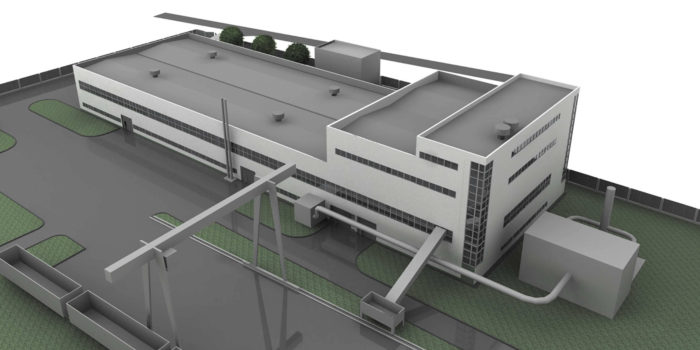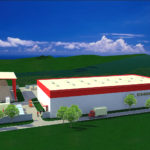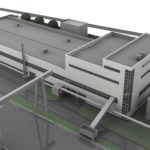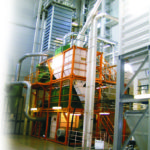The plant is generally intended for the production of thermal insulating boards made of mineral wool.
The production program of the provides the capacity of 5 tons per hour – for the melt and 26,440 tons per year – for the fiber.
A single-storey production building with dimensions of 78 meters long and 30 meters wide and a part of a 3-storey building with dimensions of 30 meters long and 30 meters wide are envisaged for the production of mineral wool boards.
While designing at a specific site the composition of the plant can be specified both by the number of buildings as well as by their size. Water abstraction intake facilities and treatment works for domestic and storm wastewater can be either within the plant complex or separately from it, depending on the specific situation of the plant site.
Technological solutions
Mineral wool boards are the main type of thermal insulation used in mass construction, the use of which is due to the increasing use of light enclosing structures in construction, as well as external thermal insulation of residential buildings.
The technological process for the production of mineral wool boards includes the following main technological stages:
- receipt, storage and preparation of raw materials, their dosing and batch preparation;
- melting the mixture and obtaining a mineral melt;
- melt production and fiber production;
- the introduction of a binder by spraying;
- bleeding the fibers from the centrifuge and equitable distribution across the width of the fiber deposition chamber, forming a mineral wool carpet of required thickness;
- premolding, dehumidifying and curing of the carpet in the polymerization chamber by suction of the heat carrying agent;
- cooling down, cutting the carpet on a format machine and packing the boards.
Architectural and construction solutions
The determining factor of architectural and construction solutions were the requirements of the technological process, which dictates the size and mutual distribution of the process equipment.
According to the plan the production of mineral wool boards is organized in the one-story part of the building with dimensions 78 * 30 m and in the 3-storey part of building with dimensions 30 * 30 m.
The outer walls of the one-story part of the building are made of gas silicate panels. Roll roofing. Farms, beams, columns, slabs and foundations – prefabricated made of reinforced concrete.
The outer walls of the multi-storey part of the building are designed from the SANDWICH type panels. The coating of metal corrugated with a mineral wool insulation with a roll of waterproof layer.
In the multy-storey part of the building the following premises are located:
- on the 1st floor – cupola compartment, afterburning room, fan room, pump room, centrifuge repair room, raw materials receiving and dispensing department, binder preparation department and ventilation chamber;
- on the 2nd floor – cupola, department for receiving and dispensing raw materials, binder preparation department, ventilation chambers;
- on the 3rd floor – a binder preparation department and a raw material receiving and dispensing department.
In the one-story part of the building the following premises are located:
- department of the production of the mineral wool boards and the finished products warehouse;
- switchgear rooms;
- control room and cupolaman room;
- electric transformer room;
- pumping station;
- lavatories.
Main construction indicators:
- Building area – 13,300 m2
- Total area – 13600 m2
- Building volume 82200 m3
Technical and economic indicators:
- Total area of 13.6 hectares
- Building area 13.3 hectares
- Building volume 82 thousand m3
- Annual electricity consumption 15347.3 MW ∙ h
- Annual consumption of natural gas 4177,52 thousand m3
- Annual water consumption 79.9 thousand m3
- Annual discharge flow of 23.5 thousand m3
- Annual compressed air consumption 1163.36 thousand m3
- Annual production program for the production of mineral wool plates: 5 t / h – for the melt; 26440 tons per fiber






